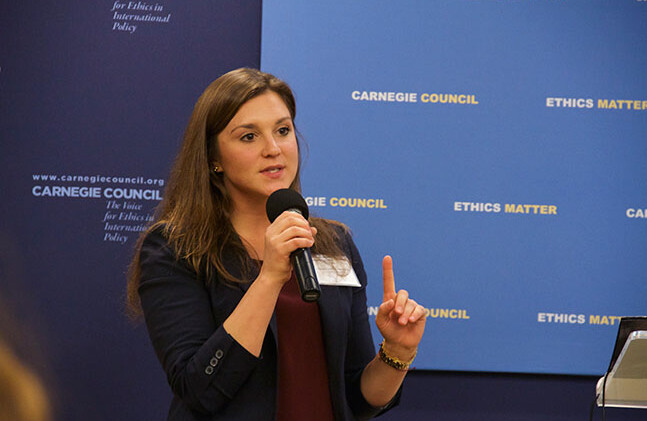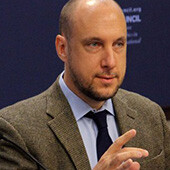On May 4, 2016, Ourania Sophia Yancopoulos' paper on gender equality was selected as the winner of the Council’s second annual Student Research Conference. Afterwards, Carnegie Council Senior Fellow Devin Stewart, who organized the conference, conducted this email interview with her.
DEVIN STEWART: What was the topic of the research you presented at Carnegie Council?
OURANIA S. YANCOPOULOS: My research highlights the apparent gender imbalance in UN leadership. While this imbalance is nothing new in the workings of the United Nations, my research is the first to reveal the full extent in hard data. My presentation accomplishes two main things. First, it provides the first trend analysis showing the proportion of women in UN leadership over decades. Second, and perhaps more important, it shows the relative progress made under each secretary-general, destabilizing the overly optimistic narrative created by the current S-G about his own efforts toward reaching the UN's 50/50 gender parity goals.
DEVIN STEWART: Why did you select that topic?
OURANIA S. YANCOPOULOS: My research was inspired by an almost year long internship at the United Nations. While there, I kept hearing that we—"the United Nations" but also local and national governments—must "empower women and girls." Why? The UN has come out time and time again linking the representation of women in decision-making to development, conflict resolution, and sustainable peace building and peacekeeping efforts. Their absence then, was repeatedly discussed at the UN as an accelerator of poverty, insecurity, and instability.
But while there, I kept hearing such statements from men. And while I kept hearing the current secretary-general claiming he had made so much progress in promoting women to senior staff—I couldn't see it. Take the current secretary-general's senior management team—it consists of 40 people, out of which 28 are men. That means in the secretary-general's so called "cabinet" there is a measly 30 percent representation by women. So given the supposed relationship between women and peace, and the apparent failure of the UN to promote gender parity within its own walls, I got interested in tracking the representation of women in UN leadership over time.
DEVIN STEWART: What was the process of doing the research?
OURANIA S. YANCOPOULOS: Now, you—like myself—might expect or might hope that the UN has clear answers to who makes up its senior staff. However, from initial conversations with the Department of Public Information, Human Resources, and even UNWomen, I found that no one had yet tracked the representation of women in the UN's top levels over decades—not even this one.
The UN is a huge, global body. Unsurprisingly, it follows that its personnel are almost impossible to keep track of. The UN's senior leadership is especially difficult to measure with different agencies, funds, and departments having different definitions, different reports, and different ways of counting. In one 2015 report there were four different ways of reporting the gender balance of staff, and after working to understand these percentages, I realized that I didn't have the statistic I wanted. In other words I couldn't find one simple statistic to explain the representation of women at all senior levels of leadership, regardless of contract type, funding, or type of engagement.
So, in the face of the UN's convoluted data gathering and reporting practices I chose to limit my research to the Secretariat: Why?
From meetings with UN departments and my advisors on the project, we decided to focus on senior positions within the Secretariat and piece together the data from the annually released: Secretary General's Report: Composition of the Secretariat: Demographics of Staff.
What's important to us—who may be outsiders to the UN—is that the Secretariat functions as the "executive branch" of the UN system: its leaders make the big decisions. It is important to look at gender equality in the Secretariat's leaders—the so-called "under-secretaries-general and assistant-secretaries-general" (USG/ASG)—because it is these leaders who are considered to be the "leaders of the UN system." From this population we are able to glean gender representation in roles where it was having vast ramifications in the work and decision-making of the world's one, truly international organization.
So, after days in the Dag Hammarskjöld library sifting through documents dating back to 1946, with brittle, yellowed pages, and after months of meetings with various experts and agencies to cross-check the numbers and verify my counts, the data I presented include all leaders of the UN Secretariat—in particular the gender breakdown of the total population of USG/ASGs actually holding that position, regardless of their contract type, source of funding, or type of engagement.
DEVIN STEWART: What were your findings?
OURANIA S. YANCOPOULOS: Right away I found that despite the UN's repeated commitment to 50/50 gender parity, the UN has never been even close to this goal. In fact the closest it ever got was in 2012 at about 24 percent.
If we look closely at the representation of women during this secretary-general's tenure we see that the S-G's claims to have "championed" the woman's cause and increase representation of women in the UN, especially at the senior levels, simply does not match the reality. In February 2016 Mr. Ban Ki-Moon claimed to have appointed "50 or 60 women" at the UN's most senior levels—"all assistant-secretary-generals and under-secretary-generals" and thereby claimed to have "changed the whole landscape for women." Not even a month later, on International Women's day, he claimed to "have signed nearly 150 letters of appointment to women" in these high positions. So what's going on?
Looking at raw numbers perhaps S-G Ban really has done the most for women—37 women in 2015—that is more than any other S-G ever appointed. However while 37 women might seem impressive if we look at number of female appointments versus total appointments, we see that inflation of male appointments diminishes the impact of new female ones. Another way to look at this is the rate of change over time: In 2006 there were 90 men compared to 20 women at the USG/ASG position. On average, Ban added to that about five new men per year, compared to adding only two new women per year. So, if the current trend continues, the UN will always favor men—unless something significant is done about it.
We see the impact in the proportions as well: In 2015, only 22 percent of the UN's leadership was women. So no, Mr. Ban has not "changed the whole landscape," in fact, at the current rate of increase, over his term: from 20 percent in 2007, to 22 percent in 2015, it will take another century for the UN to reach gender parity.
DEVIN STEWART: How have your findings been received?
OURANIA S. YANCOPOULOS: I've received a lot of feedback and interest. My article, which highlights the initial findings and methodology of this research, was published in OpenDemocracy for International Women's Day. Since then, I've been contacted by people who work on the issue of women's representation in UN leadership—academics, UN staff, even reporters. I was also asked to speak on panels regarding this issue—including by the campaign to elect a woman UN secretary-general.
DEVIN STEWART: Tell me about what you plan to do in the future regarding gender equality.
OURANIA S. YANCOPOULOS: Since publishing in OpenDemocracy this past March I have become more and more involved with the campaign to elect a woman UN secretary general—called WomanSG for short. I am now a regular contributor, and have my own blog with them. In my capacity on the WomanSG campaign I was lucky enough to attend the first ever-informal interviews with official next UN S-G nominees. In a piece to be published in OpenDemocracy later this month, I write in my personal capacity to highlight not only the difference in gender alone, but that women need to be looked at and considered as serious candidates for the position.
I am graduating from Columbia University on May 18 and after some professional experience in analytics, I hope to return to school to pursue a Masters Degree in International Affairs with a focus on women, peace, and security.
DEVIN STEWART: Why are you so passionate about this issue?
The United Nations is an organization founded to fix global problems in very different, diverse communities. When trying to solve these sorts of problems, the UN must be able to identify with the disadvantaged. It is much easier to identify with those vulnerable groups if you have a diverse group of problem solvers working together. That's why it is so important for the UN's decision-makers to not only be geographically representative of the world's people but also representative of the world population's age, gender, and experiences. The only way for the UN to be able to understand and then solve these diverse problems is to be creative, diverse, and representative of the world's people. In all countries women and men are affected differently by different circumstances. In order to best understand the issues affecting both genders, representatives of both genders need to be in senior positions making serious decisions—in other words, both genders need to have influence. In fact, the majority of the global population is women! Meaning the majority of those who are underprivileged and afflicted by various problems are women, and so it is vital to have a better balance of women in the world's one, true international organization.





